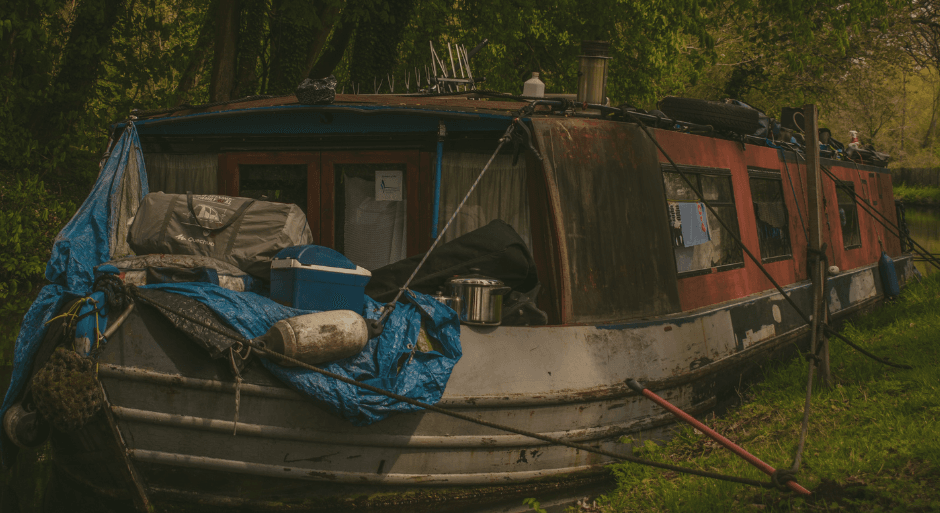Living off-grid on the inland waterways offers a unique opportunity to combine adventure, sustainability, and a close connection with nature. For those seeking an escape from the hustle of urban life, canal and riverboat living presents an appealing alternative – one that embraces a slower, more intentional way of life. Whether navigating historic canal systems or tranquil rivers set in rural landscapes, this lifestyle allows you to explore new places while maintaining a low environmental footprint.
Off-grid living on the water is not just about detaching from the traditional power grid; it’s about embracing a lifestyle that values self-sufficiency, environmental stewardship, and the freedom to move at your own pace. With thousands of kilometres of waterways around the world, many of which allow for year-round residence, living on a boat can offer unparalleled access to serene and natural environments.
This article explores the essential aspects of living off-grid on inland waterways, from selecting the right type of boat and understanding the associated costs, to navigating the practicalities of daily life on the water. Whether you’re considering a narrowboat, widebeam, barge, or another type of vessel, you’ll find valuable insights and tips to help you embark on this rewarding lifestyle.
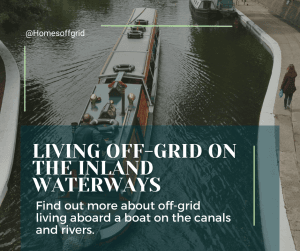
Types of Boats for Off-Grid Living
When it comes to off-grid living on inland waterways, the type of boat you choose is crucial. Different vessels offer distinct advantages and challenges, depending on the waterways you plan to navigate and your personal lifestyle preferences. Below, are some of the most popular options, each suited to different environments and living needs:
Narrowboats
Narrowboats are a classic choice for living on canals, particularly in regions with extensive networks of smaller, man-made waterways. Typically measuring between 15 and 20 metres in length and about 2 metres wide, narrowboats are designed to navigate narrow locks and bridges, making them ideal for tight canal systems.
The narrow width requires smart storage solutions and a minimalist approach to possessions it but can be efficiently utilised for cozy living quarters. With their long, narrow shape, it’s important to ensure the boat is well-insulated and equipped with efficient heating, especially for colder climates.
Widebeam Boats
Widebeam boats are similar to narrowboats but offer more width, usually ranging between 3 and 4 metres. This extra width provides a reasonably spacious interior, allowing for more flexible layouts and making it easier to create separate living areas, larger kitchens, or additional bedrooms.
Due to their size, widebeam boats are restricted to wider waterways and cannot navigate some narrow canals or locks, so it’s essential to plan your routes carefully. But these more spacious boats offer the comfort of a small apartment on water, with room for larger appliances and furniture, making them a popular choice for those who want more room to live comfortably.
Tugs
Tugboats, originally designed for towing and pushing other vessels, have found a new life as converted homes. These robust and sturdy boats are often admired for their industrial charm and strong build. Tugs are built to last, with strong hulls and powerful engines. This makes them a reliable option for those who plan to cruise more challenging waterways. These boats often come with powerful engines, but can require more regular maintenance, adding to the overall upkeep.
While tugs tend to have smaller, more confined interiors, which can be a challenge for full-time living, the space may allow for more originality in the interior design concept. If you are choosing to carry out your own conversion you could be faced with a significant project, requiring extensive modifications to create a comfortable living space, but you have the chance to make it something special.
Barges
Barges are larger vessels originally designed for transporting goods, but many have been converted into comfortable floating homes. They are usually wider and longer than narrowboats and widebeams, often exceeding 4.5 metres.
Barges offer generous living spaces, often comparable to a land-based home. They can accommodate multiple bedrooms, full-sized kitchens, and even outdoor decks.
Due to their size, barges are limited to larger rivers and canals, and navigating them requires more skill and experience. Also, larger vessels require more maintenance, particularly in terms of engine upkeep and hull preservation.
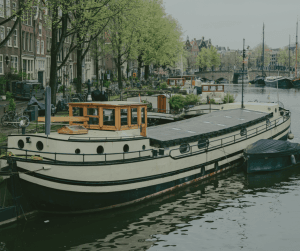
Other Boat Options
Within these common types, there are various more specific options for those interested in off-grid living on the water. For example, cruisers, which typically have a larger rear decking area, provide more outdoor space than traditional narrowboats and are popular among those who enjoy open-air living. Meanwhile, some innovative individuals have even converted emergency lifeboat pods and various workboats into comfortable floating homes, demonstrating the versatility and creativity possible in this lifestyle.
No matter the type of boat you choose, each offers a unique way to experience life off-grid on the water. Your decision will depend on your preferred lifestyle, where you intend to travel, and the level of comfort you desire.
Costs of Living Off-Grid on Inland Waterways
Living on a boat offers a unique and adventurous lifestyle, but it also comes with financial considerations. From purchasing your vessel to maintaining it and managing the costs of navigation and mooring, it’s essential to understand the expenses involved. Here’s a breakdown of the key costs you’ll need to consider:
Purchasing a Boat
The first major expense you’ll encounter is purchasing your boat. The cost of a boat can vary hugely depending on its type, size, age, and condition. Here is an overview of the prices you can expect:
- Narrowboats: Typically range from £20,000 to £150,000, depending on size, age, and condition.
- Widebeam boats: These are generally more expensive, ranging from £60,000 to £200,000 or more due to their larger size.
- Barges: Prices can vary greatly but expect to pay between £40,000 and £200,000, depending on the size and conversion status.
- Tugs: Often priced between £30,000 and £100,000, depending on the extent of conversion and the boat’s overall condition.
Aside from the size there are a number of other factors which can affect the price of a boat. Here are the main ones:
- Age and condition: Older boats may be more affordable but could require significant refurbishment. Newer boats or those in excellent condition will command higher prices.
- Customisations: Boats that have been converted or customised for comfortable living will often be more expensive than standard models.
- Location: Prices can also vary based on where you’re buying the boat, with some regions having higher demand and, therefore, higher prices.
Maintenance Costs
Once you’ve purchased your boat, ongoing maintenance is crucial to ensure its safety and longevity. Regular upkeep is not just a matter of comfort – it’s essential for preserving the boat’s value and preventing costly repairs down the line. Maintenance jobs can include the following:
- Sealing the hull: Depending on the material, you may need to have the hull inspected and resealed every few years. This can cost anywhere from £500 to £2,000.
- Engine upkeep: Regular engine servicing is vital to keep your boat running smoothly. Budget around £200 to £500 annually for routine maintenance, though more extensive repairs can be much more costly.
- Other routine expenses: These can include repainting, replacing worn-out parts, and servicing onboard systems like heating and plumbing. Annual maintenance costs can range from £1,000 to £5,000, depending on the boat’s size and condition.
Regular inspections of the boat’s hull, engine, and structure are essential to catch any issues early, prevent major damage and maintain structural integrity. Prioritising maintenance will help you avoid unexpected expenses and ensure your boat remains safe.
On the Move
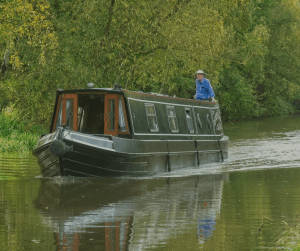
If you plan to continuously cruise rather than stay moored in one location, there are additional costs and requirements to consider. You will generally need to purchase permits for travelling:
- Licenses: Most inland waterways require a cruising license, which grants you permission to navigate the canals and rivers. Fees vary depending on the region, waterway type and the size of your boat but typically range from £700 to £1,500 per year.
- Navigation permits: In some areas, you’ll also need specific permits to access certain waterways or cross into different jurisdictions.
There are also additional costs associated with continuous cruising:
- Fuel: Your boat will need fuel for both propulsion and powering onboard systems. Fuel costs can vary widely depending on your cruising habits, but it’s wise to budget for at least £500 to £1,500 annually.
- Mooring fees: While continuous cruising means you don’t need a permanent mooring, some temporary moorings may charge fees, especially in popular or urban areas.
Mooring Costs
If you prefer the stability of a fixed location, mooring your boat in a marina or other designated area is another significant cost to consider:
- Permanent moorings: These are spaces in marinas or along canals where you can leave your boat long-term. You can stay or these moorings short-term but you are not allowed to live there full-time. Costs vary depending on location, amenities, and demand, typically ranging from £1,000 to £5,000 per year.
- Residential moorings: These allow you to live onboard while moored, often providing additional amenities like water, electricity, and waste disposal. They can be more expensive, with fees ranging from £2,000 to £10,000 or more annually.
There are financial pros and cons to both continuous cruising and more settled locations. A long-term mooring provides stability and easy access to utilities. It’s a recurring expense, but it’s ideal if you prefer a more stationary lifestyle. Meanwhile. continuous cruising offers freedom and flexibility but comes with the responsibility of finding suitable mooring spots and managing fuel and permit costs. It also requires a more self-sufficient approach to water, waste, and power management.
Understanding these costs is essential for planning your budget and ensuring that off-grid living on inland waterways is both feasible and enjoyable. By carefully considering your options and preparing for the associated expenses, you can embark on your off-grid adventure with confidence.
Off-Grid Essentials for Boat Living on Inland Waterways
Living off-grid on inland waterways requires self-sufficiency, particularly when it comes to basic necessities like heating, electricity, water, and waste management. By equipping your boat with the right systems you can create a comfortable and sustainable off-grid living environment on the inland waterways. Here’s a guide to the essential systems you’ll need to maintain comfort and sustainability on your boat.
Heating Options
Staying warm during colder months is crucial when living off-grid on a boat. Several heating solutions are available, each with its own advantages and considerations. Common off-grid heating solutions for boats include the following:
- Wood stoves: A traditional and popular choice, wood stoves provide reliable heat and can also be used for cooking. They require a steady supply of wood and a chimney for ventilation. Wood stoves are known for creating a cozy atmosphere, but they also need regular maintenance, such as cleaning the chimney and removing ash.
- Drip-fed diesel stoves: These diesel-fuelled stoves are efficient and can be left running for extended periods. Reflex stoves are highly effective in maintaining a steady temperature, making them ideal for long-term heating needs.
- Diesel heaters: Diesel heaters are compact, efficient, and easy to control. They run on diesel fuel and can heat your boat quickly. However, they require proper installation and maintenance to ensure safety and efficiency and are electronically controlled.
When using diesel or wood as a fuel source, safe and adequate storage is essential. You’ll need to have enough space to store fuel securely, away from any potential fire hazards. Diesel tanks should be regularly inspected for leaks, and wood should be stored in a dry area.

Proper ventilation is also critical for any heating system to prevent the buildup of harmful gases like carbon monoxide. Ensure that your heating system is installed with adequate ventilation and that you have a carbon monoxide detector onboard.
Electricity
Generating and managing electricity off-grid is essential for powering lights, appliances, and other electronic devices on your boat. There are various energy options available but here are the most common:
- Solar power: Solar panels are a common choice for boaters, as they are relatively easy to install and maintain. They convert sunlight into electricity, which is stored in batteries for later use. Solar power is ideal for providing a steady, renewable energy source, especially during the summer months.
- Wind turbines: Wind turbines can be a valuable addition to your off-grid setup, particularly in windy areas. They work by converting wind energy into electricity, complementing solar power during less sunny periods.
- Generators: For those times when solar and wind power are insufficient, a portable generator can provide backup power. Generators run on fuel (usually diesel, petrol or gas) and can power larger appliances or recharge your batteries when needed.
Batteries are essential for storing the electricity generated by your solar panels or wind turbine. Deep-cycle batteries are commonly used on boats, as they can be discharged and recharged multiple times without damage. Proper maintenance, including regular checks and proper charging, is crucial for extending battery life.
To make the most of your off-grid power supply, it’s important to be mindful of energy usage. Use energy-efficient appliances, LED lighting, and consider your overall power consumption. Reducing energy demand will help ensure your batteries last longer and reduce the frequency of running generators. To find out more about off-grid energy solutions click here.
Water Supply
Accessing and managing water is another critical aspect of off-grid living on a boat. Whether for drinking, cooking, or cleaning, having a reliable water supply is essential. Here are a few things to consider for obtaining and storing water off-grid:
- Water tanks: Most boats are equipped with water tanks that can store a significant amount of water. You’ll need to regularly refill your tanks from suitable water sources, such as marina water points, public taps, or even rainwater collection systems.
- Rainwater collection: Rainwater harvesting can be an effective way to supplement your water supply, especially in regions with frequent rainfall. You can install a system to collect rainwater from the boat’s roof and store it in tanks for later use. However, this water will need to be properly filtered and treated before drinking.
- Filtration systems: Installing a water filtration system onboard can ensure that your drinking water is safe. Options range from simple carbon filters to more advanced reverse osmosis systems, depending on your needs and water quality.
- Water conservation: Given the limited storage capacity on a boat, conserving water is crucial. Simple habits like taking shorter showers, using water-efficient faucets, and being mindful of leaks can significantly reduce your water usage.
Toilets and Waste Management
Managing waste effectively and in an environmentally responsible way is a key part of off-grid boat living. There are a few off-grid toilet options for you to choose between:
- Composting, or separating toilets: These toilets separate solid and liquid waste, so the solid waste can decompose into compost, reducing the need for pump-outs. They’re environmentally friendly and don’t require water, making them ideal for off-grid living. However, they do require regular maintenance, such as emptying the compost bin and ensuring proper ventilation. With normal usage the waste is not in the toilet long enough to decompose into compost, but the separation still makes using and emptying these toilets a convenient option.
- Cassette toilets: A cassette toilet is a portable toilet with a removable waste tank. The waste tank can be emptied at designated disposal points. These toilets are convenient and don’t require much space but need to be emptied frequently and typically use chemicals to help with any smell.
- Pump-out systems: Pump-out toilets are connected to a larger holding tank, which needs to be pumped out at marina facilities. This option is more convenient for long-term use but requires access to pump-out stations and incurs additional costs.
It’s important to consider the environmental impact of your waste management choices. Composting toilets are generally the most eco-friendly, while pump-out systems require careful management to avoid spills or leaks.
You should be sure to familiarise yourself with local regulations regarding waste disposal. Many waterways have strict rules about where and how you can dispose of waste, and non-compliance can result in fines or other penalties. Always use designated disposal points for cassette and pump-out toilets and follow best practices for composting.
Lifestyle Considerations
Living off-grid on the inland waterways offers a unique lifestyle, distinct from traditional living. While it comes with its own set of challenges, the rewards of a life spent close to nature can be immensely fulfilling. Here’s what you need to know about the social aspects, and the balance of challenges and rewards when living on the water.
Challenges and Rewards
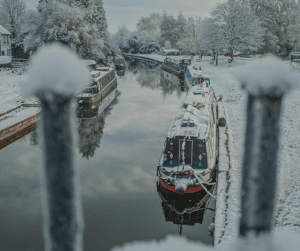
Living off-grid and on the water is not without its difficulties. Here are some of the most common challenges faced by those living on boats on inland waterways:
- Weather extremes: Living on a boat exposes you to weather extremes, such as freezing temperatures in winter and intense heat in summer. Cold winters can freeze the water around your boat, making movement difficult, while summer heat can make the metal surfaces of your boat unbearably warm. You must also be aware of high winds as they can take down trees and block waterways. Proper insulation, ventilation, and heating/cooling systems are crucial.
- Maintenance: Boats require regular maintenance to remain safe and habitable. From cleaning and painting the hull to engine upkeep and checking for leaks, maintenance can be time-consuming and costly. However, staying on top of these tasks is essential to avoid more significant problems down the line.
- Space management: Life on a boat requires you to adapt to smaller living spaces. Efficient space management is essential, with clever storage solutions and multi-functional furniture often being necessary. Every square meter counts, so you’ll need to be creative with how you organise your belongings.
- Operating the lock gates: Navigating canals and rivers often involves passing through locks, which can be physically demanding and time-consuming. You’ll need to become proficient at operating lock gates, especially if you’re cruising alone.
Despite the challenges, this water-based lifestyle can be extremely rewarding and it’s no surprise so many are drawn to it. Here are just a few of the positives:
- A slower pace of life: Life on the water often moves at a slower pace, allowing you to appreciate the simple pleasures of off-grid living. You can move your home to different locations, taking in the changing landscapes and discovering new places. The quiet of the waterways, the beauty of the natural surroundings, and the freedom to move at your own pace are some of the unique rewards of this lifestyle.
- Connection to nature: Living on a boat creates a deep connection to the natural environment. You’ll wake up to the sound of birds, witness beautiful sunrises over the water, and feel more connected to the natural world. This closeness to nature is one of the most appealing aspects of off-grid living on the inland waterways.
- A sense of adventure: Off-grid living on the water offers a sense of adventure and exploration that’s hard to find elsewhere. Every journey along the waterways is an opportunity to discover new places, meet new people, and experience life from a different perspective. This adventurous spirit is one of the most compelling reasons people choose to live on the water.
- Financial freedom: Living on a boat allows you to move away from increasing electricity bills, rent or mortgage payments and many of the additional costs that come from living in a traditional house. When living on a boat there are still expenses such as licenses, mooring fees and fuel costs but you have much more financial independence.
Community and Social Aspects
The boating community is often close-knit, with a strong sense of camaraderie among those who live on the water. You’ll also meet people from diverse backgrounds, united by a common love for life on the water. Boaters tend to look out for each other, sharing tips, advice, and assistance when needed. This sense of community can be comforting, especially for those new to off-grid living.
Many regions have boating clubs or associations that organise events, social gatherings, and meet-ups for boaters. Joining these groups can be a great way to connect with others who share your passion for off-grid living. Meanwhile, many moorings along the canals and towpaths have friendly bars where you can gather and meet others in the area.
The internet is also home to many forums, social media groups, and websites dedicated to boating and off-grid living. These platforms offer valuable resources, support, and opportunities to connect with like-minded individuals, no matter where you’re moored.
In embracing the lifestyle of living off-grid on the inland waterways, you’ll find a mix of challenges and rewards that create a unique, fulfilling way of life. Whether it’s the connection to nature, the community of fellow boaters, or the simple joy of life on the water, this lifestyle offers something truly special for those willing to adapt.
Practical Tips for Success
Planning and Preparation
Transitioning to off-grid boat living can take time and careful planning. Here are some top tips to maximise your chances of succeeding in adapting to this alternative lifestyle:
- Start with research: Before making the leap to off-grid boat living, immerse yourself in research. Read books, watch documentaries, and join online forums to gather as much information as possible. The more you know about the realities of life on the water, the better prepared you’ll be for the transition.
- Plan your budget: Off-grid living can be cost-effective, but it still requires a financial plan. Outline your expected expenses, including the purchase of the boat, maintenance, permits, and living costs. Having a clear budget will help you avoid unexpected financial strain.
- Gain practical skills: Operating a boat and navigating waterways requires specific skills, such as steering, docking, and managing locks. Take a boating course or learn from experienced boaters to acquire these skills before setting off on your journey. Knowing how to operate lock gates, in particular, is essential for safe and smooth travel on canals and rivers.
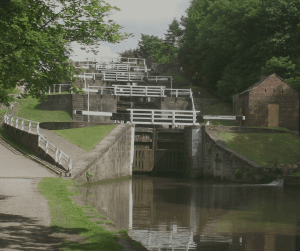
- Test the waters: Before committing to a full-time off-grid lifestyle on the water, consider renting a boat for a few weeks or months. This trial period will give you a taste of what life is like on the water and help you determine if it’s the right fit for you. It also provides valuable hands-on experience with boat operations and maintenance.
- Choose the right boat for your needs: Selecting the right boat is one of the most important decisions you’ll make. Consider factors such as size, layout, condition, and suitability for the waterways you plan to navigate. For example, if you’ll be cruising narrow canals, a narrowboat might be ideal, while larger waterways may allow for larger boats like widebeams or barges.
- Inspect the boat thoroughly: Before purchasing, have the boat inspected by a qualified surveyor to identify any potential issues. This inspection can help you avoid costly repairs and ensure the boat is seaworthy and suitable for off-grid living.
- Prepare for life on the water: Transitioning to boat life requires mental and physical preparation. Understand that living on a boat involves daily maintenance, space management, and adapting to a different pace of life. Try to mentally and physically prepare yourself for these changes by visualising your daily routines and potential challenges.
Staying Compliant with Regulations
As part of your preparation for moving onto the waterways it is essential to understand how to navigate the legal and regulatory requirements:
- Understand the regulations: Living on the water involves adhering to various legal and regulatory requirements. These can include boating licenses, navigation permits, safety inspections, and environmental regulations. Familiarise yourself with the rules in your region to ensure you’re compliant and avoid potential fines or legal issues.
- Register your boat: Ensure your boat is properly registered with the relevant authorities. This registration is often mandatory and may be required for securing permits or moorings. Keep your registration documents up to date to avoid complications.
There are a number of resources you can use for staying informed about changes in laws and regulations:
- Join boating associations: Many regions have boating associations or clubs that provide members with updates on legal and regulatory changes. Joining these organisations can help you stay informed and connected with the broader boating community.
- Monitor official websites: Government and maritime authority websites often publish updates on boating regulations, permits, and safety guidelines. Regularly check these resources to stay current with any changes that may affect your off-grid lifestyle.
- Ask around: In marinas and sometimes along the canals you may find individuals who volunteer or work for the waterway authorities. If in doubt you can ask for updates or clarifications and you should be able to find the answers to any of your regulatory questions.
Embracing the Off-Grid Mindset
It can be both mentally and physically challenging to adapt to any kind of off-grid living. Living on a boat is a big shift in reality for many but with the right mindset you should thrive on the water:
- Adopt a resilient mindset: Off-grid living on the water can be challenging, especially during extreme weather conditions or when dealing with maintenance issues. Embrace a resilient mindset, understanding that challenges are part of the journey and can be overcome with patience and determination.
- Embrace simplicity: Living off-grid often means simplifying your life, reducing your reliance on modern conveniences, and focusing on what truly matters. Cultivate an appreciation for the simplicity and self-sufficiency that off-grid living offers.
- Stay flexible: Flexibility is key to thriving in an off-grid lifestyle. Conditions on the water can change rapidly, from weather patterns to mechanical issues, so be prepared to adapt your plans. This adaptability will help you navigate the unexpected and make the most of your experience.
- Build a support network: Surround yourself with a community of like-minded individuals who can offer advice, support, and encouragement. Whether through online forums, local boating clubs, or friendships developed along the waterways, having a support network can make all the difference in your off-grid journey.
By carefully planning, staying informed about regulations, and adopting the right mindset, you’ll be well-equipped to succeed in your off-grid life on the inland waterways. This lifestyle offers a unique blend of freedom, simplicity, and connection to nature, making it an attractive option for those seeking a different way of living.
Conclusion
Living off-grid on the inland waterways offers a unique and rewarding lifestyle that combines freedom, simplicity, and a deep connection with nature. There are many important things to consider before shifting to this way of life, from choosing the right boat to understanding the costs and maintenance involved. You need to choose which off-grid systems will suit you for heating, electricity, water, and waste management, and you must be prepared for the inevitable lifestyle changes and obstacles you might face on your journey.
While there are certainly challenges to living off-grid on a boat, including space limitations, weather conditions, and regulatory compliance, the rewards are significant. This lifestyle allows you to live more sustainably, enjoy nature, and embrace a slower, more intentional way of living. The sense of community among fellow boaters and the opportunity to explore new places at your own pace add to the allure.
For those considering this unique lifestyle, the key is thorough planning, preparation, and a willingness to adapt. Whether you’re drawn to the idea of continuous cruising or prefer the stability of a mooring, living off-grid on the inland waterways offers a fulfilling and adventurous way of life. With the right mindset and resources, you can navigate the challenges and fully enjoy the many joys that come with this off-grid journey.
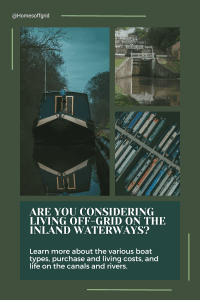
If you’re more interested in life at sea check out this article.
To learn more about living off-grid explore the Reading Room.


